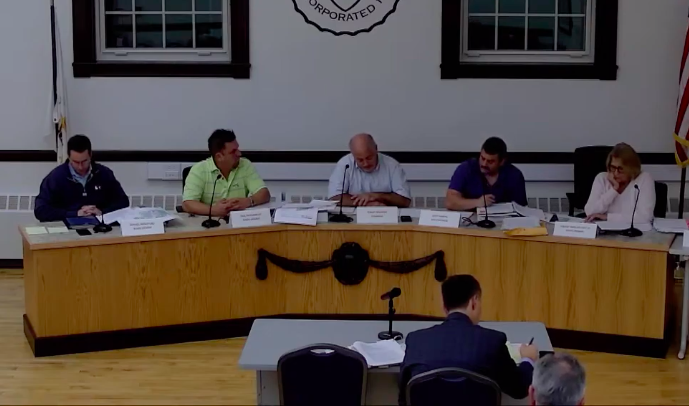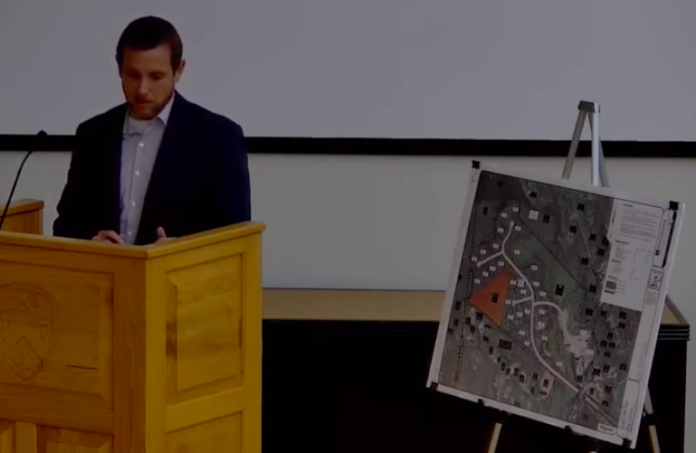NORTH SMITHFIELD – Despite warnings that the property could legally be developed into 30 residential lots, members of the North Smithfield Zoning Board of Review voted 4-1 Tuesday night to deny a request for special use permits and a variance for the project known as Gold solar.
The unique proposal aimed to see a 9-megawatt commercial solar array installed on a portion of an 112-acre property on Mattity Road owned by the Gold family. As part of the proposal, the entire parcel would be turned over to the town for recreational use, with a 37-acre portion leased back to the developer for energy production for a period of 25 years.
Pitched, in part, as a way for the property owners to garner some economic benefit while providing town residents with a rich and historically valuable piece of land for open space, the project has been in the works for more than a year. The late David Gold had tried to sell the land to the town before his death last August, and had ultimately offered the solar proposal as an alternative after negotiations failed.
But the plan required approval of two special use permits and a dimensional variance by zoners, and would also have needed Town Council approval for potential relocation of a previously established conservation easement.
“It’s a rather complex application,” noted Zoning Board Chairman Robert Najarian.
David Russo of DiPrete Engineering noted that the property could be divided into 30 lots – all with septic systems – and remain zoning compliant. He noted that removal of the conservation easement would allow for better access to the proposed solar system and would be better both, “environmentally and economically.”
With the proposed array 2.4 miles from the nearest substation, engineers working with the developer estimated it would already cost $2.5 million to extend National Grid lines to the site.
“It just makes better sense,” Russo said of building on the area with the easement.
Attorney John Mancini said that if the application was denied, the property owner would submit plans for a 30-lot subdivision, which have already been drafted.
“Regardless, the Gold family is moving on with this property,” Mancini said. “It’s going to be sold. It’s going to be developed.”
Najarian walked through each of the three zoning requests, noting that applicant Anthony Delvicario seemed to have satisfied the provisions for both special use permits, needed to allow the commercial array to be built in a residential zone, and erected in a watershed district.
The chairman said it was outside his board’s purview to weigh in on the proposed removal of the conservation easement.
“We don’t have any legal jurisdiction to determine if the easement is a wonderful idea, a bad idea,” Najarian said.
But Najarian pointed to several issues with Delvicario’s request for a dimensional variance, which requires in part, demonstrating hardship due to the unique characteristics of subject land. The town’s ordinance limits such arrays to 6 acres, far below the 37 proposed.
“We have no clear definition of hardship in the form that we are accustomed to seeing,” Najarian said.
Najarian also noted that the project would alter general character of surrounding area, and that granting the variance would amount to conferring “special privilege,” to the applicant.
“They determined that they wanted 9 megawatts,” Najarian said. “It’s a self imposed threshold.”
He said the project also failed to meet the requirement that approving a dimensional variance would provide the “least relief necessary,” and that failure to get one amount to, “more than mere inconvenience,” for the applicant.
“You established a threshold that was far above the ordinance,” Najarian said to the developer. “The applicant is asking for significantly more acreage beyond what is provided for in the ordinance.”
The chairman noted that statute dictates that when pieces of such a project are linked, the elements are heard – and approved or denied – as one.
“It’s all or nothing in this instance,” he said.

Zoner Paul Pasquariello, the only board member to ultimately vote in favor of approval, pointed to the project’s merits when taken as a whole.
“They wanted to sell this to the town years ago,” Pasquariello said. “We decided they didn’t want to pay for it. The way to get their money out of it is to have the solar pay for it.”
The scenic property boasts miles of hiking trails previously maintained by Gold, and unique historic features including a former piggery. It was opened to residents for several months in 2020, just as the project obtained master plan approval from the Planning Board last July.
“The plan to gift land to the town isn’t relevant to the board in terms of a hardship,” Najarian responded. “We have no clear hardship that has been presented by the applicant.”
“Not only do we owe the applicant a thorough and legal proper review, we owe it to the taxpayers and abutters who may have a different opinion,” Najarian said. “I have a similar thought as it relates to the merits, however, my specific responsibility as the chairman is to try to steer the ship according to the rules, and it’s not an easy matter.”








